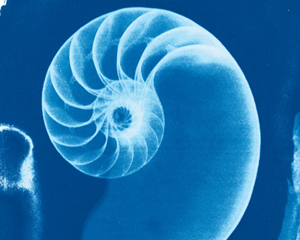You can see it in the logarithmic whorl of a nautilus. The milky iridescence of an abalone. The spiked turret of a queen conch. Precision, elegance, strength.
這些特性你可以在鸚鵡螺的對(duì)數(shù)螺旋狀螺層上看到。可以在鮑螺的乳白色虹彩上看到。也可以在女王鳳凰螺的尖狀螺塔上看到。那就是精準(zhǔn)、優(yōu)雅、強(qiáng)韌。
The seashell is a consonance of form and function that both rivals and guides human creativity.
貝殼是形態(tài)與功能的調(diào)和,既可媲美人類的創(chuàng)造力,也引導(dǎo)了人類的創(chuàng)意。
From Botticelli's "Birth of Venus" to Frank Lloyd Wright's design for the Guggenheim Museum in New York, shells have inspired artists and architects throughout history.
從波提切利的“維納斯的誕生”,到弗蘭克·勞埃德·賴特為紐約古根海姆博物館所做的設(shè)計(jì),歷來許許多多藝術(shù)家和建筑師都從貝殼汲取靈感。
Our admiration for seashells even predates writing.
我們甚至在有文字之前就懂得欣賞貝殼。
Archaeologists in Israel recently unearthed the remains of a clamshell necklace made about 120,000 years ago.
以色列考古學(xué)家最近挖出一條蚌殼項(xiàng)鏈的殘片,是距今約12萬年前制作的。
As enduring as our fascination with seashells are the mysteries they hold.
貝殼的神秘面紗也和我們對(duì)貝殼的迷戀一樣歷久不衰。
How did such complex and beautiful structures come into existence?
如此復(fù)雜而美麗的構(gòu)造,到底是怎么形成的?
Evolution by natural selection can help explain why shells became widespread among mollusks, but it cannot fully elucidate how an individual creature builds a skeleton as exquisite as, say, the exceptionally spiny shell of a Venus comb murex.
自然選擇的進(jìn)化或許能解釋貝類為什么會(huì)變成分布很廣的軟體動(dòng)物,卻無法完整闡明單一個(gè)體,比如說維那斯骨螺,如何形成長滿尖刺的精致骨架。
To truly understand the seashell, we must peer beneath its biology to the underlying math and physics.
想要真正了解貝殼,就必須探究貝類生理構(gòu)造背后的數(shù)學(xué)與物理學(xué)。
In recent years, scientists undertaking such work have developed a considerably more sophisticated understanding of the physical forces that guide shell formation.
近年來,從事這方面研究工作的科學(xué)家已經(jīng)對(duì)主導(dǎo)貝殼形成的物理作用力獲得更深入的見解。

Innovative studies by Derek Moulton, a professor of applied mathematics at the University of Oxford, and his colleagues have revealed that much of the astonishing variety of seashells can be explained by a few simple mathematical principles.
牛津大學(xué)應(yīng)用數(shù)學(xué)教授德瑞克·摩爾頓和同事的創(chuàng)新研究發(fā)現(xiàn),只要少數(shù)幾個(gè)簡單的數(shù)學(xué)原理,就能解釋貝殼大部分的驚人多樣性。
Every mollusk's body is surrounded by a mantle, a cloaklike organ that secretes calcium carbonate and mixes it with a scaffolding of protein to form a shell one layer at a time.
所有的軟體動(dòng)物都有一層外套膜包裹著,這層像斗篷般的器官會(huì)分泌碳酸鈣,并把碳酸鈣和支架蛋白混合在一起而逐漸層疊形成貝殼。
As a mollusk expands its shell, it adds new material to only one area: the opening, or aperture.
隨著軟體動(dòng)物的殼越長越大,新的材料只會(huì)增添在一個(gè)部位:開口處,稱為殼口。
Envision this as a circle. If, with each new layer, a mollusk deposits a ring of material the same size as the aperture, its shell will lengthen into a cylinder.
把這個(gè)開口想像成一個(gè)圓形。如果一個(gè)軟體動(dòng)物每次形成一層殼時(shí)沉淀出的一圈新材料,都跟殼口一樣大,他的殼就會(huì)逐漸加長,最后變成圓柱狀。
If, instead, the mollusk increases the circumference of each new ring, its shell will become a cone.
而要是這個(gè)軟體動(dòng)物每次都讓那圈新材料的圓周長增加一些,他的殼就會(huì)變成圓錐狀。
By depositing more material on one side of the opening than the other, a mollusk can curve a cylindrical shell into a doughnut.
只要讓開口的其中一邊沉淀的材料比另一邊多,他就能把圓柱狀的殼彎曲成甜甜圈的形狀。
Imagine gluing a stack of lopsided rings, one atop another -- each thicker on its left side than its right.
現(xiàn)在再想像要把一疊左邊比右邊厚的材料圈黏在一起,一圈接著一圈往上疊。
Instead of forming a neat cylindrical tower as uniform rings would, they'd arc to one side -- like the wedges in a stone archway -- and eventually make a loop.
最后黏成的形狀不會(huì)像左右兩邊均勻的材料圈所形成的筆直圓柱,而是會(huì)彎向一邊,就像石造拱門的楔形石塊一樣,最后形成環(huán)狀。
By rotating the points where the mantle secretes more or less material, a mollusk can twist such a loop into a spiraling tube.
如果再把外套膜分泌較多或較少材料的位置輪替一下,這哥軟體動(dòng)物就可以把這種環(huán)狀物扭轉(zhuǎn)成螺旋形的管狀了。












